Pygmy Three-Toed Sloths are the world’s smallest sloths. Pygmy three-toed sloths have a slow metabolism and can be found in northern South America. These species are not endangered, but they are considered vulnerable to extinction because of habitat loss and fragmentation.
The Pygmy Three-Toed Sloth requires greater protection from human involvement for its survival, especially as climate change causes their habitats to be threatened with increased temperatures and drought.
- Status: Critically endangered
- Known as: Pygmy Three-Toed Sloth, Dwarf sloth, monk sloth
- Estimated numbers left in the wild: Likely less than 100.
Description of Pygmy Three-Toed Sloth
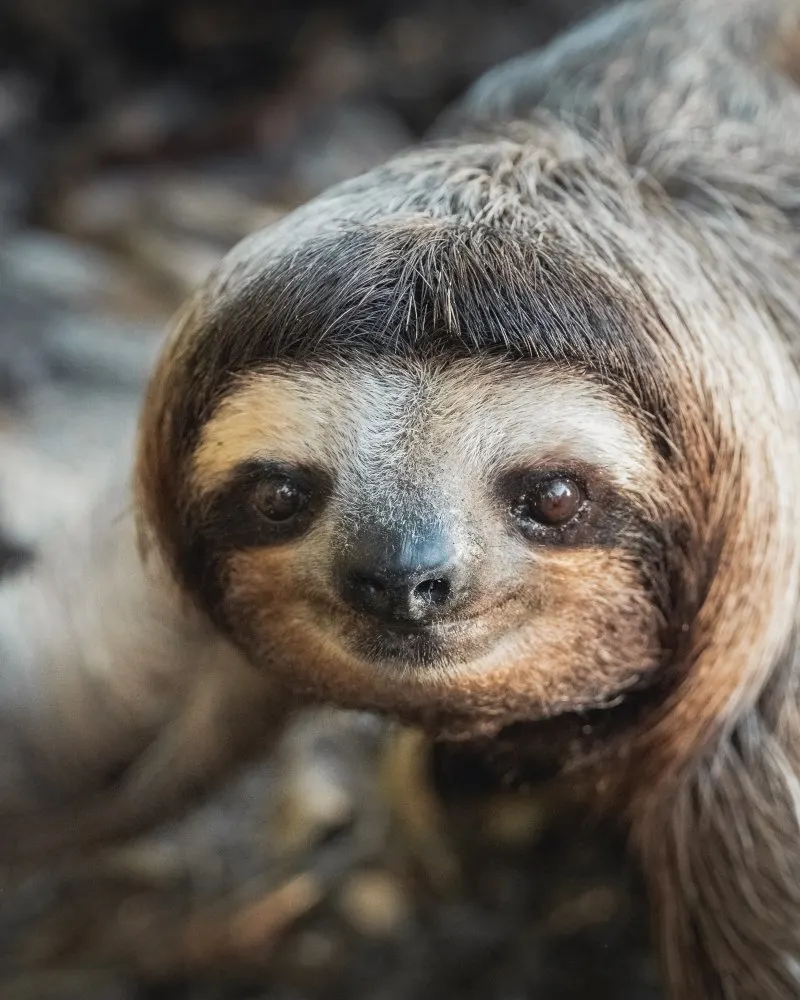
Pygmy three-toed sloths are an excellent example of insular dwarfism, which occurs when a population is confined to an island and must adapt to the limited resources of space and food.
These sloths look compact and are approximately 40% smaller than the mainland sloths they are descended from. Weight is just 2.5 to 3.5 kilograms, while length ranges from 48 to 53 centimeters.
The sloth’s fur is grey, though the face is tan with chocolate stripes, and the male has an orange patch on the back divided lengthwise by a black stripe.
There is long hair on this sloth’s head, hanging down and giving the appearance of a hood, inspiring the alternative name of “monk sloth”.
A unique species of symbiotic algae grows in the fur of the pygmy three-toed sloth, giving their fur a greenish tint that acts as excellent camouflage when combined with their slow movements.
Habitat
Pygmy three-toed sloths spend most of their lives in trees, though they must descend to the ground to urinate and defecate. They can only crawl while on the ground, though they are good swimmers. In the trees, they hook themselves securely to branches with the three large claws on each of their feet.
They often hang upside down from branches while in the trees. Their sole food is the leaves of the red mangrove trees where they live.
Breeding & mating
The mating behavior of these sloths is a mystery, but scientists believe it is the same as that of other sloths. Sexual maturity is probably reached at around three years, and young are born after a gestation of six to twelve months.
Loud vocalizations enable the male and female to find each other in their leafy habitat.
The female has one offspring, rarely twins, who cling to her underside for the first period of their lives.
The young sloth may remain with its mother for up to a year, during which time its fur acquires the species’ signature symbiotic algae from the colonies growing on her hair.
Location
Separated from the Panamanian coast by 17 kilometers of ocean, the island of Escudo de Veraguas is the only home of the pygmy three-toed sloth.
The sloths live only in red mangroves as a type of terrain found in a narrow band along the seaside, which are estimated to cover just 1.5 square kilometers.
About the Pygmy Three-Toed Sloth
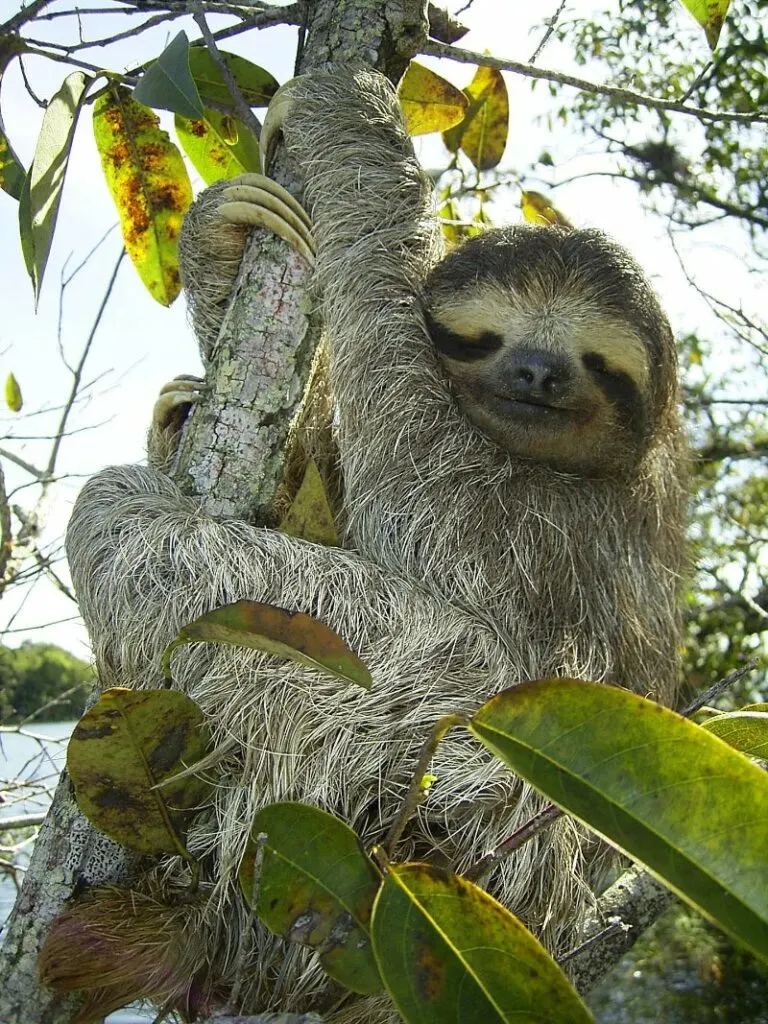
The pygmy three-toed sloth is native to Isla Escudo de Veraguas, which is part of the Republic of Panama. For 9,000 years, it has been detached from mainland Panamanian.
The sloth is a slow mover and excels at life in mangroves. The sloth is also a good swimmer!
The pygmy three-toed sloth’s biggest worry is habitat loss. It shrinks the size of its already limited living space.
Because of an island dwarfism phenomenon, pygmy three-toed sloths are the tiniest member of their species.
The pygmy three-toed sloth is only one of four members in the three-toed sloth group Bradypus. Sloths usually only go to the ground when they need to do their business, which can happen up to seven days after they’ve last gone.
Since pygmy three-toed sloths move so slowly, they use camouflage and stealth to protect themselves. They avoid predators by staying hidden. Rats, on the other hand, due to their robust hides, powerful grips, and exceptional healing abilities, can generally withstand assaults.
There is a kind of green algae found in the fur of the pygmy three-toed sloth that serves as camouflage without harming the animal. The pygmy three-toed sloth’s algae grow throughout childhood and are most likely passed from parent to youngster.
Pygmy Three-Toed Sloth Life
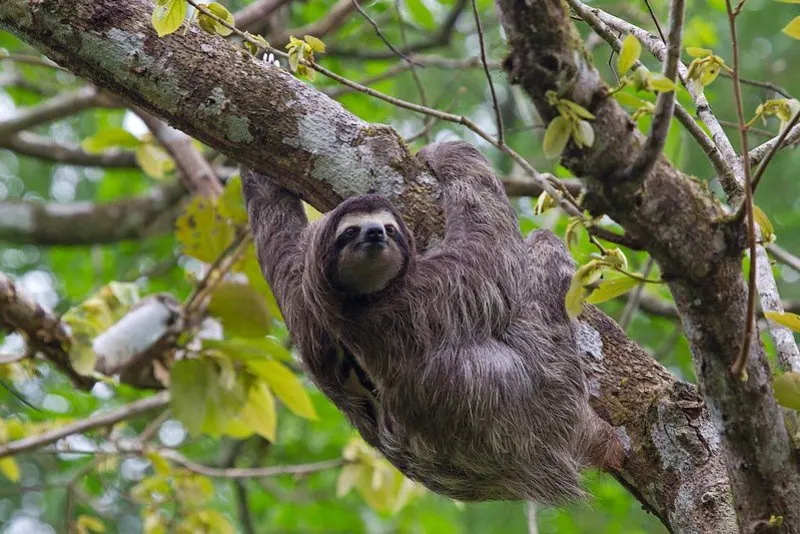
Pygmy three-toed sloths live in the trees and spend a lot of time there. Their claws assist them in gripping branches, and they can even hang from them after they are dead. Sloths sleep in trees. Every day, they sleep for 15 to 20 hours.
They don’t move much even when awake. At night, they consume leaves, shoots, and fruit from the trees and get almost all of their water from juicy plants.
Sloths mate in the trees. When they are giving birth, they may even do so from a limb. Baby three-toed sloths cling to their moms for the first few months of their life.
Sloths have poor hind legs and lengthy claws. They dig with their front claws and then drag their bellies using their powerful front legs.
If these animals are on land, they have no chance to get away from big cats. So they have to try to defend themselves by scratching or biting.
Sloths are not good at walking on land, but they are good at swimming in the water. Sometimes, they fall from trees into rivers and swim with their long arms.
Pygmy Three-Toed Sloth threats
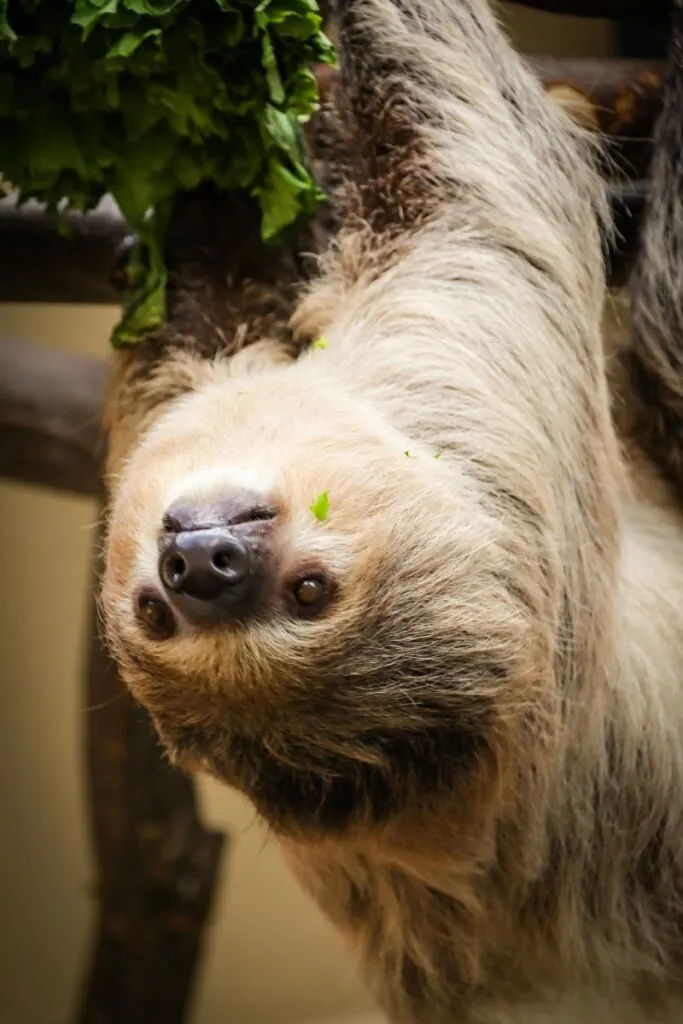
The population of pygmy three-toed sloths has been declining due to habitat degradation and fragmentation, human exploitation for food, the presence of feral cats like the jaguar, and a lack of adequate legal protection.
While their own island is deserted, seasonal visitors, including fishermen, lobster divers, and native people have been known to hunt sloths. The sloths’ recent fame has also made them a target for capture and export for public display.
In 2013, the Dallas World Aquarium attempted to export eight pygmy sloths but was unsuccessful after indigenous people, police, environmental organizations, and Panamanian authorities worked with aquarium officials to secure the release of the sloths. At least two of the intercepted sloths died before being set free.
See Related: Different Types of Ivy Plants (+ Examples)
Conservation of Pygmy Three-Toed Sloth
Threats
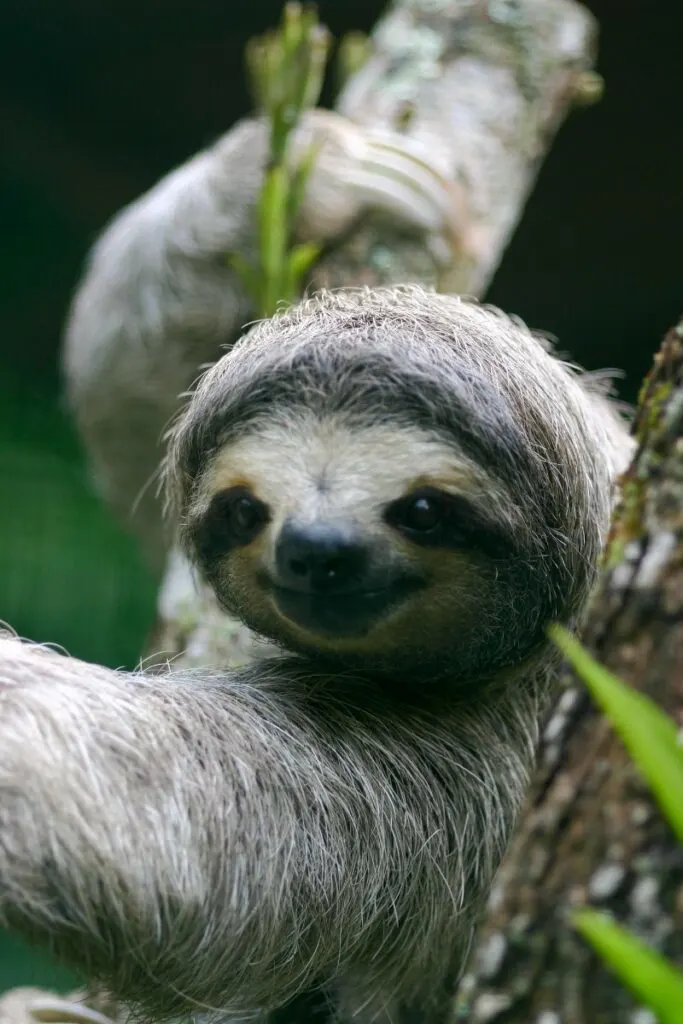
Since they are confined to one island surrounded by oceanic waters, every hectare of habitat is vitally important to pygmy three-toed sloths. Unfortunately, vigorous cutting of mangrove trees is occurring on Escudo de Veraguas.
If unchecked, this could lead to the outright extinction of these intriguing, dwarf mammals. Surreptitious hunting by fishermen operating near the island may also be occurring since the sloths are an easy source of meat.
Conservation efforts
These sloths are theoretically protected, but there is practically no actual enforcement of the ban on hunting them or destroying their habitat.
Money is being gathered to change the local economy to a more sustainable model that will not witness as much cypress logging or sloth poaching, and greater enforcement of protective measures is also possible.
Organizations
Do you know of or are you a part of an organization that works to conserve the Pygmy three-toed sloth, then please contact us to have it featured on Our Endangered World.
Conclusion
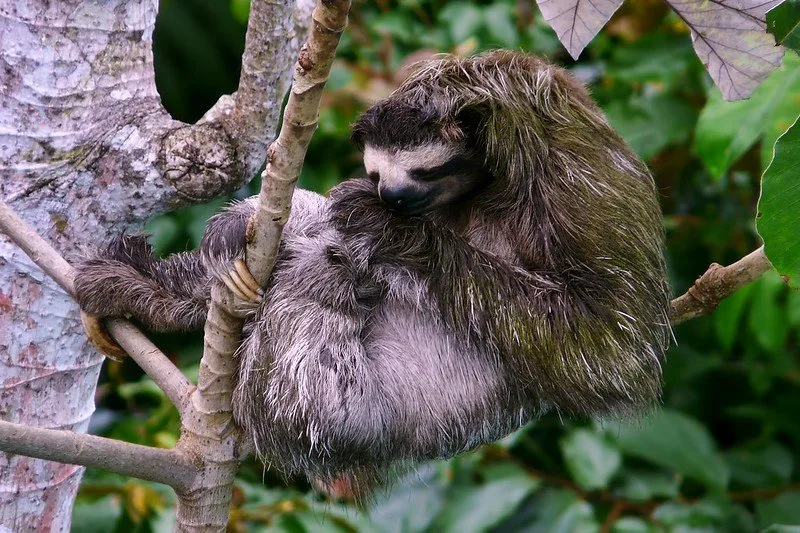
The world’s smallest sloths are Pygmy Three-Toed Sloths, which weigh about 2.0 to 4.6 kg (4 oz.). Males have an orange patch on their back divided lengthwise by a black stripe, and because of their sluggish metabolism, they appear small.
The Pygmy Three-Toed Sloth lives in mangrove trees as a sort of ground found along the coast, which covers just 1.5 square kilometers. Pygmy three-toed sloths live in trees for the most part, but they must descend only for urinary and defecation needs.
Sloths are endangered, and they’re also known as “the world’s slowest mammal.”
The Pygmy Three-Toed Sloth is the world’s most poorly understood sloth species.
Pygmy Three-Toed Sloth populations are shrinking due to loss of habitat, climate change along with hunting by fishermen are factors that may hinder the Pygmy Three-Toed Sloth population from extinction.
FAQ
What are Pygmy Three-Toed Sloths?
The most well-known feature of the Pygmy Three-Toed Sloths is their ability to swim. They are said to be about 40% smaller than their mainland counterparts. They weigh around 3 kg and are around 24 inches long, resembling brown-throated sloths.
Pygmy sloths are a diminutive form of brown-throated three-fingered sloths found on the mainland of Panama, although this species is endemic to the isolated Isla Escudo de Veraguas. This tiny island, which formed 9000 years ago and is located 17.6 kilometers off the coast of mainland Panama, measures just 4.3 km2.
Because of the lack of study, we still do not have genetic information on the pygmy sloths; however, they were first described as a distinct species in 2001 based on morphological variations in body size (they are reportedly 40% smaller than the mainland variety).
Why are Pygmy Three-toed Sloths slow?
The sloth’s sluggishness stems from its slow metabolism, which is why it gets its name. Sloths subsist on leaves, twigs, and buds as they traverse canopy vines from one tree to the next. They never shed and require no maintenance. Because they don’t have teeth, they use their hard lips to scrape leaves — hence the reason for such a firm grin. Sloths can survive on relatively little food because of their low metabolic rate.
Pygmy Three-Toed Sloths use slow motion, less distance traveled, and minimal searching through the leaves to avoid detection by predatory hawks and cats that hunt by sight. The sloth’s digestive system, on the other hand, creates a rather severe problem when it comes to excreting. It takes days for sloths to digest what other animals can process in hours because of their slow digestion rate.
These species have a slow digestive system, so they need to defecate only once every week. In the process, they lose about one-fifth of their body weight, according to scientists. This natural pendulum swing of a rare bowel movement pattern with a huge release of waste is by design in evolution.
Sloths are generally found in trees, however one study claims that over 50% of sloths die when they travel to the forest floor. That is why they only venture down to the ground to go pee if their spouse calls far away.
Is Pygmy Three-Toed Sloth endangered?
The most recent data on these sloths are devastating, suggesting that there may be as few as 48 of them remaining—a far cry from the prior estimate of 79 in 2013. The pygmy three-toed sloth has been classified as “critically endangered” by the International Union for Conservation of Nature since 2006.
It is not listed as threatened or endangered, but in November 2013 we petitioned the Fish and Wildlife Service to have it listed under the Endangered Species Act. This will provide a lot of protection for this animal.In June 2014, the USFWS agreed with AWI’s petition and found it to be valid for a period of 90 days. This finding meant that if a decision was not made within 12 months, a listing would be required.
Although the USFWS originally stated that it intended to issue a 12-month determination in FY 2017, this did not happen, and the agency now claims that it does not have a specific date for issuing a final decision.
The Department of the Interior’s failure to take any action in response to the petition is unprecedented and unlawful under the Endangered Species Act. It violates the law’s express requirement, and it is almost certain to exacerbate pygmy sloth population declines and raise the species’ risk of extinction. The state of California may file a civil claim to enforce the Department’s statutory obligations. NWI may pursue legal action against USFWS to compel it to comply with its legal duties.
Other Species Profile
See Related

